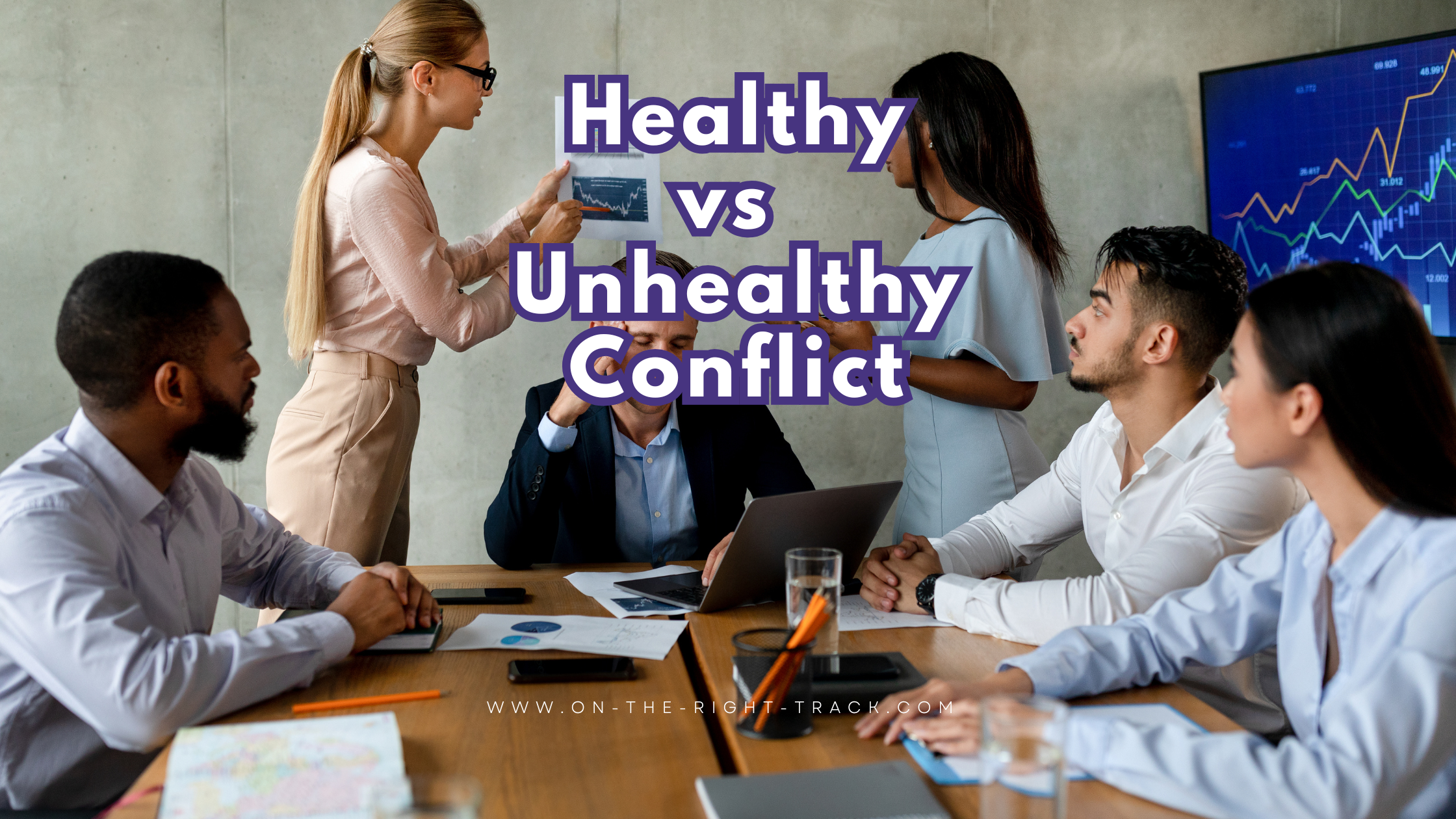My brother and I love to debate. Give us a topic, tell me which side to represent, and I’m game. The two of us love to push buttons for one another, but at the end of the day, we engage in a healthy debate. We don’t take it personally, and at the end of the discussion, it is common for one to say to the other, “That was a really good point. I hadn’t thought of that.” We use our debates to share our opinions and learn from one another.
Unfortunately, not everyone debates that way at all. Debate is not always conflict, conflict is not always healthy, and conflict is not created equally.
Workplace conflict happens daily and can strengthen or weaken a team depending on how it is managed. While some conflicts can be healthy and lead to innovation and growth, unresolved conflicts can hurt employee morale and productivity. Conflict around ideas, for example, can fuel innovation and create stronger teams. In contrast, interpersonal conflict often divides and undermines productivity.
To distinguish healthy conflict from unhealthy conflict, let’s start with working definitions:
Unhealthy Conflict: This is interpersonal conflict, usually based on personal grievances, miscommunications, or perceived slights. It is unproductive and divides people, leading to stress and resentment. Unhealthy conflict tends to be based on emotional responses rather than facts and focuses on people rather than ideas. People don’t listen to other points of view and attack others for not thinking the way they think.
Healthy Conflict: This occurs around ideas and encourages open discussion of different viewpoints. Healthy conflict strengthens teams by allowing members to voice their opinions openly without fear of judgment. This type of conflict is constructive, driving creativity and leading to more refined and well-thought-out solutions. It doesn’t attack but instead values different points of view.
Unhealthy conflict comes from several sources: unresolved past issues, misunderstandings, control issues, clashing personalities, or even jealousy. This type of conflict is destructive because it revolves around personal issues rather than professional ideas, and the outcomes are almost always negative. Here’s how unhealthy conflict typically appears in the workplace:
- Personal Attacks and Gossip: When disagreements become personal, they often lead to attacks on character rather than constructive discussions. Gossip can also spread, damaging reputations and destroying trust.
- Blame Game: Unhealthy conflict often involves assigning blame to individuals rather than discussing how to solve a problem. It leads to defensiveness, and team members may be unwilling to admit mistakes. It doesn’t matter what happened; what matters is who did or said what.
- Avoidance or Aggression: If you ever had to avoid someone you work with because you don’t get along, you are experiencing unhealthy conflict. If you can’t avoid one another, the conversation is often passive-aggressive, which is obvious to everyone listening. This often creates a “team” approach to conflict. Are you on Team Rhonda or Team Troy? It makes it uncomfortable and unproductive for everyone when it feels like we are still in high school.
- Loss of Focus on Organizational Goals: I belong to an association where we have had an unhealthy conflict that affected the entire association. One person wanted option “A,” and another wanted option “B.” It quickly became personal between the two people, and it felt like the association’s goals weren’t important, but instead, winning was more important for one of the participants. It divided the membership, which impacted everyone.
We know that unhealthy conflict creates a toxic environment. It destroys morale, reduces collaboration, and often results in increased turnover and unengaged team members. If you’ve experienced unhealthy conflict, you may feel alone and isolated, unappreciated, or unsupported, which impacts your overall performance.
On the flip side, healthy conflict can act as a catalyst for positive change. Healthy conflict is not about winning or losing; it’s about finding the best solution for the organization. When encouraged and managed effectively, healthy conflict fosters a culture of trust and open communication. Here’s what healthy conflict looks like:
- Focus on Ideas, Not Individuals: Healthy conflict revolves around problem-solving and innovation. By focusing on ideas rather than people, everyone feels safe sharing different opinions, which builds respect and inclusivity. My brother Troy and I not only love to debate, but we also like to learn from one another. I know that his perspective on things has changed my approach to some things.
- Increased Creativity and Innovation: Since we feel comfortable disagreeing with one another (in fairness, we look forward to it), we bring diverse perspectives to the table, which creates innovative solutions.
When Warren and I bought and renovated our home in 2020, Troy challenged one of our ideas for the family room. In the end, we took his approach and were thrilled with the final result. His perspective was valuable, and we benefited from his creativity.
- Better Decision-Making: By considering multiple viewpoints, teams are more likely to make well-rounded decisions. “Group think” is when we all think the same way and lack creativity, ideas, and perspectives. Groups need to have healthy debate so we can see the issue from different angles and make more informed choices.
- Strengthened Team Dynamics: Healthy conflict promotes open communication and trust, which can deepen relationships among team members. It reinforces that all opinions are valued and respected.
- Clearer Goals and Roles: When people discuss issues openly, they clarify expectations and responsibilities. Healthy conflict forces teams to articulate their objectives and ensures everyone is on the same page, making it easier to achieve organizational goals.
Healthy conflict is a hallmark of high-performing teams and healthy work cultures. Last week, my article was about not fitting into your workplace culture. However, having unhealthy conflict in your workplace creates an unhealthy culture where you may feel you don’t belong.
I recently worked with an association where I had an opinion that was not valued. I expressed my opinion, and I felt I was open and professional. I was told, in fairly clear terms, “This is how we do it. If you don’t like it, we have many speakers to take your place.”
I realized this is not a culture I want to be part of. It wasn’t a healthy discussion. It didn’t need to be conflict, but it was clearly shown I wasn’t allowed to express my concern. I won’t be speaking there again either.
Healthy conflict encourages others to feel comfortable to voice their concerns and perspectives, which creates a stronger, more adaptable, and healthy organization.
Want to know how to create healthy conflict at work and with your colleagues?
- Establish Ground Rules for Communication: Make sure everyone understands the difference between attacking ideas and attacking people. Ground rules for respectful communication can make a big difference.
- Model Constructive Disagreement: Be the leader and set the tone for how conflict is handled. By demonstrating how to disagree respectfully and focus on ideas, you can show others that speaking up is safe.
- Encourage Active Listening: Encourage everyone to listen actively, ask clarifying questions, and refrain from interrupting. This promotes understanding and reduces the chance of personal attacks.
- Focus on Solutions, Not Problems: When conflict arises, redirect discussions towards finding solutions rather than dwelling on problems.
- Share this article. #BlameRhonda. By sharing the info openly and potentially putting it on the agenda for your next team meeting, you can get everyone on board with creating a healthy place to work
Even when you do everything right, sometimes things still go wrong. If we become attached to our ideas, our emotions can take over. If we react vs act, we can say or do something that will be received as a personal attack. Even healthy conflict can go sideways occasionally, so be sure you remember exactly how to have healthy conflict. And always remember, you both need to feel the same way. Just because you are keeping it as a healthy disagreement doesn’t mean the other person is.
Conflict is neither good nor bad; it is how it is managed that determines its impact. We need to create a culture where everyone feels valued and valuable. Everyone needs to feel comfortable to express their thoughts without fear of retribution. Conflict can be healthy and can build a culture of respect, trust, and innovation. In the long run, workplaces that handle conflict productively are better equipped to face challenges, adapt to change, and achieve lasting success.
This article was written by Rhonda Scharf and not by artificial intelligence.










